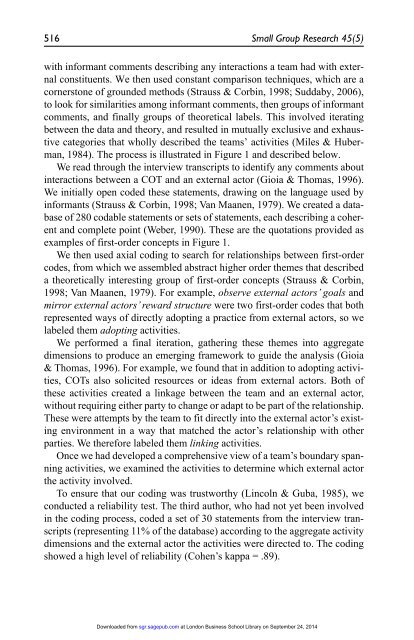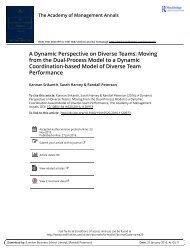The Process of Team Boundary Spanning in Multi-Organizational Contexts - Sarah Harvey, Randall S. Peterson, and N. Anand
Work teams must increasingly operate in complex environments characterized by multiple external actors beyond team and organizational boundaries. Although previous research demonstrates the importance of boundary spanning activities to team effectiveness, it reveals relatively little about the process of boundary spanning in these environments. In this article, we investigated the processes of boundary spanning across multiple external actors in 10 cross-organizational teams. We identified three sequences for reaching out to external actors: (a) moving inside-out from vertical actors inside the host organization to horizontal actors outside of the host organization, (b) moving outside-in from horizontal actors to vertical, and (c) staying-inside with vertical actors from the host organization. Our observations suggest that inside-out and outside-in sequences were more successful than simply pleasing the host organization. We build on our empirical findings to develop a process theory of how team boundary spanning activities across multiple external actors influence team effectiveness. Our research underscores the importance of a team’s interactions with actors in its external environment beyond those in an immediate supervisory role and provides insight into the dynamics of boundary spanning in multi-organizational contexts.
Work teams must increasingly operate in complex environments
characterized by multiple external actors beyond team and organizational
boundaries. Although previous research demonstrates the importance of
boundary spanning activities to team effectiveness, it reveals relatively little
about the process of boundary spanning in these environments. In this article,
we investigated the processes of boundary spanning across multiple external
actors in 10 cross-organizational teams. We identified three sequences for
reaching out to external actors: (a) moving inside-out from vertical actors inside
the host organization to horizontal actors outside of the host organization,
(b) moving outside-in from horizontal actors to vertical, and (c) staying-inside
with vertical actors from the host organization. Our observations suggest
that inside-out and outside-in sequences were more successful than simply
pleasing the host organization. We build on our empirical findings to develop
a process theory of how team boundary spanning activities across multiple
external actors influence team effectiveness. Our research underscores the
importance of a team’s interactions with actors in its external environment beyond those in an immediate supervisory role and provides insight into the
dynamics of boundary spanning in multi-organizational contexts.
You also want an ePaper? Increase the reach of your titles
YUMPU automatically turns print PDFs into web optimized ePapers that Google loves.
516 Small Group Research 45(5)<br />
with <strong>in</strong>formant comments describ<strong>in</strong>g any <strong>in</strong>teractions a team had with external<br />
constituents. We then used constant comparison techniques, which are a<br />
cornerstone <strong>of</strong> grounded methods (Strauss & Corb<strong>in</strong>, 1998; Suddaby, 2006),<br />
to look for similarities among <strong>in</strong>formant comments, then groups <strong>of</strong> <strong>in</strong>formant<br />
comments, <strong>and</strong> f<strong>in</strong>ally groups <strong>of</strong> theoretical labels. This <strong>in</strong>volved iterat<strong>in</strong>g<br />
between the data <strong>and</strong> theory, <strong>and</strong> resulted <strong>in</strong> mutually exclusive <strong>and</strong> exhaustive<br />
categories that wholly described the teams’ activities (Miles & Huberman,<br />
1984). <strong>The</strong> process is illustrated <strong>in</strong> Figure 1 <strong>and</strong> described below.<br />
We read through the <strong>in</strong>terview transcripts to identify any comments about<br />
<strong>in</strong>teractions between a COT <strong>and</strong> an external actor (Gioia & Thomas, 1996).<br />
We <strong>in</strong>itially open coded these statements, draw<strong>in</strong>g on the language used by<br />
<strong>in</strong>formants (Strauss & Corb<strong>in</strong>, 1998; Van Maanen, 1979). We created a database<br />
<strong>of</strong> 280 codable statements or sets <strong>of</strong> statements, each describ<strong>in</strong>g a coherent<br />
<strong>and</strong> complete po<strong>in</strong>t (Weber, 1990). <strong>The</strong>se are the quotations provided as<br />
examples <strong>of</strong> first-order concepts <strong>in</strong> Figure 1.<br />
We then used axial cod<strong>in</strong>g to search for relationships between first-order<br />
codes, from which we assembled abstract higher order themes that described<br />
a theoretically <strong>in</strong>terest<strong>in</strong>g group <strong>of</strong> first-order concepts (Strauss & Corb<strong>in</strong>,<br />
1998; Van Maanen, 1979). For example, observe external actors’ goals <strong>and</strong><br />
mirror external actors’ reward structure were two first-order codes that both<br />
represented ways <strong>of</strong> directly adopt<strong>in</strong>g a practice from external actors, so we<br />
labeled them adopt<strong>in</strong>g activities.<br />
We performed a f<strong>in</strong>al iteration, gather<strong>in</strong>g these themes <strong>in</strong>to aggregate<br />
dimensions to produce an emerg<strong>in</strong>g framework to guide the analysis (Gioia<br />
& Thomas, 1996). For example, we found that <strong>in</strong> addition to adopt<strong>in</strong>g activities,<br />
COTs also solicited resources or ideas from external actors. Both <strong>of</strong><br />
these activities created a l<strong>in</strong>kage between the team <strong>and</strong> an external actor,<br />
without requir<strong>in</strong>g either party to change or adapt to be part <strong>of</strong> the relationship.<br />
<strong>The</strong>se were attempts by the team to fit directly <strong>in</strong>to the external actor’s exist<strong>in</strong>g<br />
environment <strong>in</strong> a way that matched the actor’s relationship with other<br />
parties. We therefore labeled them l<strong>in</strong>k<strong>in</strong>g activities.<br />
Once we had developed a comprehensive view <strong>of</strong> a team’s boundary spann<strong>in</strong>g<br />
activities, we exam<strong>in</strong>ed the activities to determ<strong>in</strong>e which external actor<br />
the activity <strong>in</strong>volved.<br />
To ensure that our cod<strong>in</strong>g was trustworthy (L<strong>in</strong>coln & Guba, 1985), we<br />
conducted a reliability test. <strong>The</strong> third author, who had not yet been <strong>in</strong>volved<br />
<strong>in</strong> the cod<strong>in</strong>g process, coded a set <strong>of</strong> 30 statements from the <strong>in</strong>terview transcripts<br />
(represent<strong>in</strong>g 11% <strong>of</strong> the database) accord<strong>in</strong>g to the aggregate activity<br />
dimensions <strong>and</strong> the external actor the activities were directed to. <strong>The</strong> cod<strong>in</strong>g<br />
showed a high level <strong>of</strong> reliability (Cohen’s kappa = .89).<br />
Downloaded from sgr.sagepub.com at London Bus<strong>in</strong>ess School Library on September 24, 2014
















